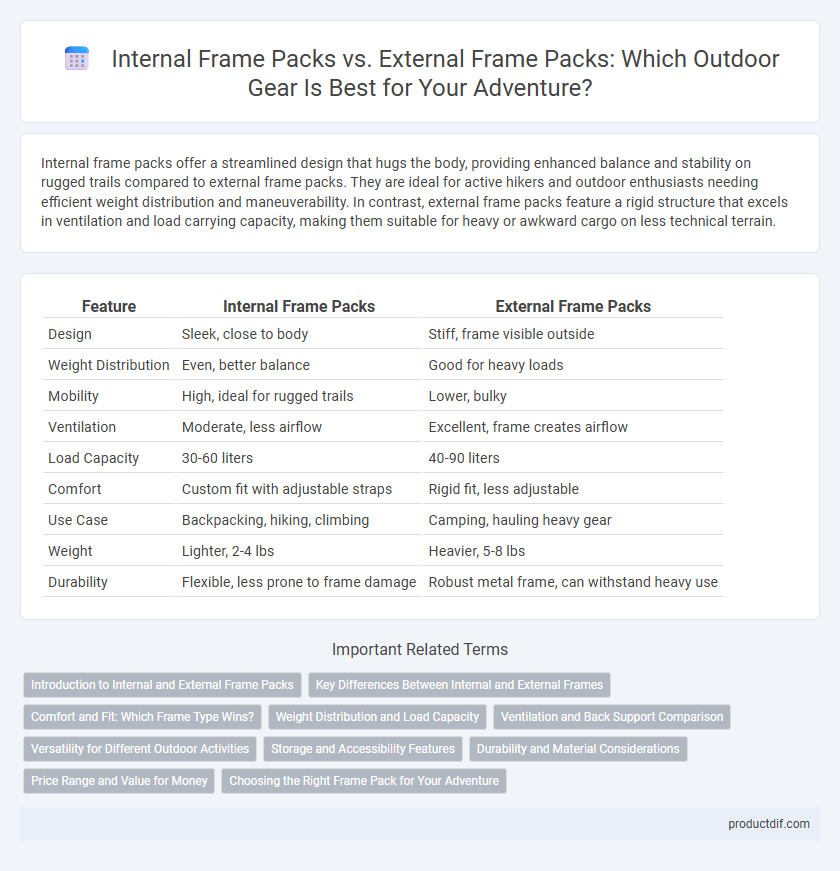Internal frame packs offer a streamlined design that hugs the body, providing enhanced balance and stability on rugged trails compared to external frame packs. They are ideal for active hikers and outdoor enthusiasts needing efficient weight distribution and maneuverability. In contrast, external frame packs feature a rigid structure that excels in ventilation and load carrying capacity, making them suitable for heavy or awkward cargo on less technical terrain.
Table of Comparison
| Feature | Internal Frame Packs | External Frame Packs |
|---|---|---|
| Design | Sleek, close to body | Stiff, frame visible outside |
| Weight Distribution | Even, better balance | Good for heavy loads |
| Mobility | High, ideal for rugged trails | Lower, bulky |
| Ventilation | Moderate, less airflow | Excellent, frame creates airflow |
| Load Capacity | 30-60 liters | 40-90 liters |
| Comfort | Custom fit with adjustable straps | Rigid fit, less adjustable |
| Use Case | Backpacking, hiking, climbing | Camping, hauling heavy gear |
| Weight | Lighter, 2-4 lbs | Heavier, 5-8 lbs |
| Durability | Flexible, less prone to frame damage | Robust metal frame, can withstand heavy use |
Introduction to Internal and External Frame Packs
Internal frame packs feature a streamlined design with a frame built into the pack itself, offering enhanced balance and mobility for rugged outdoor activities. External frame packs have a visible metal frame outside the pack, providing superior ventilation and the ability to carry heavy loads more easily on uneven terrain. Choosing between internal and external frame backpacks depends on hiking style, load weight, and terrain preferences.
Key Differences Between Internal and External Frames
Internal frame packs feature a streamlined design with the frame integrated inside the pack, providing closer weight distribution and enhanced balance for agile movement on rugged trails. External frame packs have a rigid frame on the outside, offering greater ventilation and the ability to carry bulky or irregular loads more easily, suitable for heavy, extended trips. Internal frames generally prioritize compactness and stability, while external frames emphasize load capacity and comfort over long distances.
Comfort and Fit: Which Frame Type Wins?
Internal frame packs provide superior comfort and fit due to their close-to-body design, which enhances balance and stability on uneven terrain. External frame packs often offer better ventilation and load distribution but can feel bulkier and less contoured to the back, affecting overall comfort during long hikes. For most hikers prioritizing comfort and a streamlined fit, internal frame packs are generally the preferred choice.
Weight Distribution and Load Capacity
Internal frame packs provide superior weight distribution by positioning the load closer to the body's center of gravity, enhancing balance and stability on uneven terrain. External frame packs typically offer higher load capacity, making them ideal for carrying heavy, bulky gear during extended trips. Choosing between the two depends on the need for comfort and mobility versus maximum carrying capacity.
Ventilation and Back Support Comparison
Internal frame packs offer superior back support by contouring closely to the spine, enhancing stability and balance on uneven terrain. Their design typically incorporates advanced ventilation channels and mesh back panels, promoting airflow and reducing sweat accumulation. External frame packs provide good ventilation due to the gap between the frame and the back, but they lack the ergonomic support of internal frames, making them less ideal for heavy, dynamic loads.
Versatility for Different Outdoor Activities
Internal frame packs offer superior versatility for diverse outdoor activities due to their close-to-body design, which enhances balance and mobility on uneven terrain. External frame packs excel in carrying heavy or bulky loads, making them ideal for extended backpacking trips or hauling gear like firewood or hunting equipment. Choosing between the two depends on activity type, with internal frames favored for hiking and climbing, while external frames suit heavy-load, slower-paced excursions.
Storage and Accessibility Features
Internal frame packs offer streamlined storage with multiple compartments and padded sleeves, enhancing organization and accessibility for outdoor enthusiasts. External frame packs provide superior load stability and ventilation, featuring large, open main compartments that simplify access to bulky gear and faster packing. Choosing between these designs depends on prioritizing compact organization versus easy accessibility and ventilation during extended outdoor excursions.
Durability and Material Considerations
Internal frame packs typically feature lightweight, flexible materials such as aluminum or carbon fiber frames encased in high-denier nylon or polyester, offering enhanced durability and better load stability for rugged outdoor use. External frame packs use heavier steel or aluminum frames exposed outside the pack, providing superior support for heavy loads and improved ventilation but potentially compromising long-term durability due to external frame exposure. Material choices in internal frame packs favor water-resistant coatings and abrasion-resistant fabrics, while external frame packs prioritize robust hardware and frame corrosion resistance for extended outdoor expeditions.
Price Range and Value for Money
Internal frame packs typically range from $100 to $350, offering better weight distribution and comfort for backpackers, making them a cost-effective choice for long hikes. External frame packs, priced between $80 and $250, provide greater ventilation and load stability, often favored for carrying heavy or bulky gear. Evaluating value for money depends on the specific outdoor activity, with internal frames excelling in mobility and external frames delivering affordability and load capacity.
Choosing the Right Frame Pack for Your Adventure
Internal frame packs offer better balance and stability, making them ideal for technical terrain and fast-paced hiking. External frame packs provide superior ventilation and load distribution, suitable for heavy loads and extended backpacking trips. Selecting the right frame pack depends on your specific adventure type, terrain, and carrying capacity requirements to ensure comfort and efficiency.
Internal frame packs vs External frame packs Infographic

 productdif.com
productdif.com